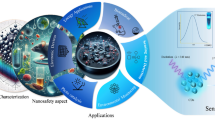Abstract
Functionalization of the surfaces of silica particles is often the first step in their various applications. An improved heterogeneous Fmoc-Cl fluorescent assay using an aqueous solution was developed to detect the number of amino groups on solid-phase supports. The fluorescent Fmoc-Cl method is 50-fold more sensitive than the current UV assay using an organic solvent. This method, together with the homogeneous fluorescamine and OPA assays, is used to detect amino groups on the silica particle surface. The accuracy and effect factors of these methods were examined and the assays were optimized. The results showed that the amine groups on silica particles can produce stronger fluorescence than small amine molecules in solution, because the porous structure of the particle surface is a more hydrophobic environment. The number of active amino groups that can be conjugated with biomolecules is much less than the total number of amino groups on the silica particle. Compared with physical methods, chemical assays involving direct reaction with amino groups would furnish the closest result to the number of active amino groups on the particle surface.

Fluorescence emission of Fmoc-Cl in aqueous solution and linear correlation between intensity and concentration









Similar content being viewed by others
References
Gill S, Price BA, Jones CW (2007) J Catal 251:145–152
Banerjee S, Santra S (2009) Tetrahedron Lett 50:2037–2040
Trave E, Bello V, Enrichi F, Mattei G, Borsella E, Carpanese M, Falconieri M, Abate C, Herlin-Boime N, Jursiokova K, Costa F, Costa L, Gini L (2005) Opt Mater 27:1014–1019
Mornet S, Elissalde C, Bidault O, Weill F, Sellier E, Nguyen O, Maglione M (2007) Chem Mater 19:987–992
Correa-Duarte MA, Sobal N, Liz-Marzan LM, Giersig M (2004) Adv Mater 16:2179–2184
Burns A, Ow H, Wiesner U (2006) Chem Soc Rev 35:1028–1042
Knopp D, Tang D, Niessner R (2009) Anal Chim Acta 647:14–30
Sokolova V, Epple M (2008) Angew Chem Int Ed 47:1382–1395
De M, Ghosh PS, Rotello VM (2008) Adv Mater 20:4225–4241
Chen Y, Chi Y, Wen H, Lu Z (2007) Anal Chem 79:960–965
McCaman MW, Robins E (1962) J Lab Clin Med 59:885–890
Kaiser E, Colescott RL, Bossinger CD, Cook PI (1970) Anal Biochem 34:595–598
Weigele M, DeEernardo SL, Tengi JP, Leimgruber W (1972) J Am Chem Soc 94:5927–5928
Udenfriend S, Stein S, Bohlen P, Dairman W, Leimgruber W, Weigele M (1972) Science 178:871–872
Zhu R, Kok WT (1998) J Chromatogr A 814:213–221
Roth M (1971) Anal Chem 43:880–882
Aminot A, Kerouel R (2006) Mar Chem 98:223–240
Herbert P, Santos L, Alves A (2001) J Food Sci 66:1319–1325
Kay C, Lorthioir OE, Parr NJ, Congreve M, McKeown SC, Scicinski JJ, Ley SV (2000/2001) Biotechnol Bioeng 71:110–118
Gude M, Ryf J, White PD (2002) Lett Pept Sci 9:203–206
Corsia K, Chellata F, Yahiaa L, Fernandes JC (2003) Biomaterials 24:1255–1264
Kell AJ, Simard B (2007) Chem Commun 1227–1229
Steinberg G, Stromsborg K, Thomas L, Barker D, Zhao C (2004) Biopolymers 73:597–605
Simons SS Jr, Johnson DF (1976) J Am Chem Soc 98:7098–7099
Simons SS Jr, Johnson DF (1978) J Org Chem 43:2886–2891
Mopper K, Delmas D (1984) Anal Chem 56:2557–2560
Nakamura H, Tamura Z (1981) Anal Chem 53:2190–2193
Simons SS Jr, Johnson DF (1978) Anal Biochem 90:705–725
Montigny P, Stobaugh JF, Givens RS, Carlson RG, Srinivasachar K, Sternson LA, Higuchi T (1987) Anal Chem 59:1096–1101
Carpino LA, Han GY (1972) J Org Chem 37:3404–3409
Einarsson S, Josefsson B, Lagerkvist S (1983) J Chromatogr 282:609–618
Einarsson S, Folestad S, Josefsson B, Lagerkvist S (1986) Anal Chem 58:1638–1643
Acknowledgment
We acknowledge financial support of this work by the National Natural Science Foundation of China (grant nos 60671014, 20775012).
Author information
Authors and Affiliations
Corresponding author
Electronic supplementary materials
Below is the link to the electronic supplementary material.
ESM 1
(PDF 39.5 kb)
Rights and permissions
About this article
Cite this article
Chen, Y., Zhang, Y. Fluorescent quantification of amino groups on silica nanoparticle surfaces. Anal Bioanal Chem 399, 2503–2509 (2011). https://doi.org/10.1007/s00216-010-4622-7
Received:
Revised:
Accepted:
Published:
Issue Date:
DOI: https://doi.org/10.1007/s00216-010-4622-7




